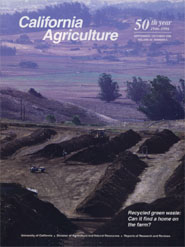All Issues

Recycled green waste: Can it find a home on the farm?
Cover:
In the response to the rapid depletion of landfill capacity, the California Legislature enacted a law mandating landfill disposal reductions of 25% by 1995 and 50% by the year 2000. Sonoma Composting diverts green waste from landfills and converts it into a rich soil amendment. Photo by Jack Kelly Clark.
September-October 1996
Volume 50, Number 5
Volume 50, Number 5





